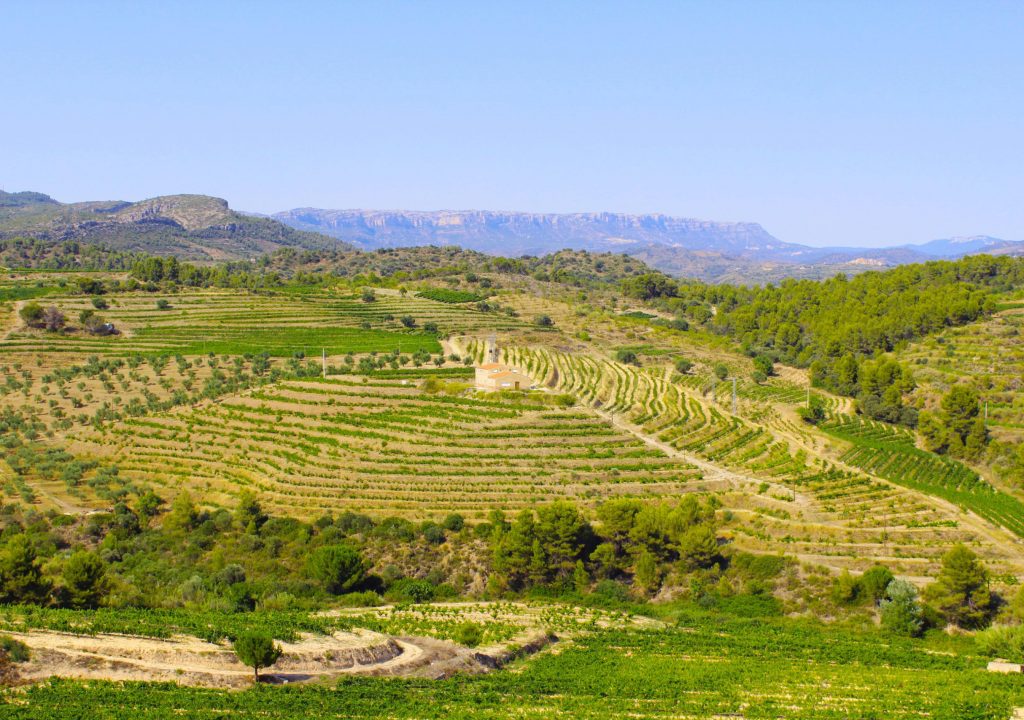Terroir of El Molar
A unique climate and soils of
around 360 million years of age
Our soils were formed about 360 million years ago and contain carboniferous slate with marine fossils that provides the ideal condition to produce wines of high mineral expression.
DOQ Priorat & Mountain Wines
of El Molar
The small mountainous region of Priorat is located in the heart of Tarragona, a Catalan province in northeast Spain. The Grifoll Declara family owns two wineries in the small town of El Molar, located in the southwestern part of Priorat.
In El Molar, we are one of only two towns in the region that – thanks to the geological characteristics of its soils – can use two different qualified denominations of origin: DOQ Priorat and DO Montsant.
It is because of this singularity, and the enthusiasm of making products of greater quality, that we decided to create the wine label Mountain Wines in El Molar. Our soils in Montsant are more like those of the Priorat DOQ (i.e. mountainous, steep slopes, slate stone). Mountain Wines are backed by both the Spanish and European governments, providing maximum control and traceability, and ensuring we only use grapes from our own vineyards.

Vineyeard in El Molar
100% self-owned vineyards

Grifoll Declara in Mountain Wines
From our own vineyards
in El Molar

What are Mountain Wines?
In 2017, Grifoll Declara voluntarily removed the winery out of the DO Montsant. Since January 2018, the vineyards and winery (that originally had been certified as DO Montsant) are now being produced in an independent system with an external audit and quality control called “Mountain Wines (MWEM)”, which is backed by the Spanish and European governments.
All our MWEM wines are based on organic farming, pursuing higher quality and protecting our terroirs and the environment.
Soil
What we call MWEM (Mountain Wines of El Molar) is a local area in the village of El Molar in the Priorat region.
Our Mountain Wines vineyards are located in the steep Western part of El Molar. Our wine cellars are next to each other or on mixed soils, and mostly show similar characteristics to those of DOQ Priorat. However, our soils are more complex as they are shaped by rocky hills with high unevenness, and mixed between sands, slate (Llicorella) and a slight touch of clay.
Difference to Grifoll Declara in DOQ Priorat
The climate is the same as where the winery Grifoll Declara is located in DOQ Priorat.
Is there a difference between MWEM and DOQ Priorat in El Molar?
Yes, there are several small factors. It depends on each farm as well. But the biggest difference is the soil condition.
Grifoll Declaration in DOQ Priorat
From our own vineyards
in El Molar

Climate
The complex terrain of the Priorat region has a major influence on its climate. The hilly terrain is surrounded by large mountains, often keeping rain clouds from making it into the valley. Air pockets can linger around for days, making the summers hot and dry. However, at night it cools down, reaching temperatures of around twenty degrees. In winter, temperatures can drop below zero.
Cold, dry north-westerly winds create stark contrasts between the valleys. El Molar benefits from a lot of sunshine, however rain is scarce. With sometimes less than 200 l/m2 per year, it has one of the lowest precipitation rates in Priorat.
Soil
Priorat is a very rugged wine region with slate soil that is locally known as llicorella. The soil is relatively acidic, but it is very porous and drains well.
The roots of the vines look for water and nutrients in these fragile brown and bluish stones. It is the distinctive Priorat soil that gives its wines their unmistakable character.
The geographical and climatic conditions cause very low grape yields with an average of less than 400 grams per centenary plant (Gran Predicat Negre), giving the wine a unique and mineral personality.

Cut of soil layer at Finca Más de Bast (MWEM)
• Sands, Clays (Panal) and Slate (Llicorella)
• Age of formation
2 million years old (Panal)
360 to 300 million years (Llicorella)
• Type of soil
Formed by accumulation of colluvial sediments
• Characteristics
Very soft and deep clay soil with a range of ochre colors. Brown or bluish-colored rock of laminated fracture composed of silts that form sheets of several millimeters or centimeters of size (Llicorella)
• Vine cultivation
Due to its proximity to Priorat, the slate soil is mixed with a layer of limestone, Rohm (Panal) and clay. The slate spreads thinly between 25 to 30 centimeters. It is an extremely rough and complex soil for grapes. Since the soil of the calcareous layer contains a high pH level and an abundance of calcium, acidic-tasting grapes grow here. Although the soil is dry with only average annual rainfall of approx. 200 l/m2, the soil can nevertheless keep the moisture thanks to the limestone and clay as they have good water-retention capability.

Cut of soil layer at Finca Tafall (DOQ Priorat)
• Carboniferous Slate (Llicorella)
• Age of formation
360 to 300 million years
• Type of rocks
Metamorphic
• Characteristics
A brown-bluish rock with laminated fractures consisting of mud and with fine slabs.
• Vine cultivation
The typical slate soil of the Priorat is called llicorella.
Since there is little rainfall in the region, the roots of the vines grow deeply into the slate soil in search of moisture and nutrients. The result is a unique wine with a mineral personality, strong notes and balanced acidity. Additionally, the sunlight exposure has a positive effect on the photosynthesis and the ripening process of the grape.

• Altitude: 180 to 550 m
• Vineyard location: Most slopes exceed the slope gradient of 10%, with some Fincas reaching 25%
• Precipitation: Around 200L / m2
• Mediterranean climate: the influence of wind and topographic barriers such as mountains.
• Soil diversity: Limestone, Rohm (Panal), clayey, slate.
• Characteristic of the grapes: small with low planting density (2500 vines/ha), and due to location, climate and temperature, it contains phenolic compounds.
• Characteristic of the wine: elegant with fresh fruits providing a balanced acidity that expresses the aromas and flavors, as well as with the distinct personality of the MWEM soil.
• Annual grape production: 120,000 kg, with an average of 1350 grams per vine.
• Vineyards: 78 ha, of which 42 ha are 80-year-old vines and the rest being between 30 and 45 years of age.

Altitude: 110 to 565 m
• Vineyard location: Most slopes exceed the slope gradient of 18%, with some Fincas reaching 45%.
• Precipitation: About 200 L/m2
• Mediterranean climate: the influence of wind and topographic barriers such as mountains.
• Terrain: slate stone (llicorella) with slight touches of clayed sand.
• Characteristics of the grape: Small with low planting density (3,500 vines/ha), and due to location, climate and temperature, it contains phenolic compounds.
• Characteristics of the wine: Balanced, complex, fresh due to its good presence of acidity with expressive aromas and flavors as well as its unique personality.
• Vineyards: 42 ha, of which 30 are over 50-year-old vineyards and the rest being between 25 and 55 years of age.
“Gran Predicat Negre” is the exception as it produces 400 grams per vine from 100-year-old vines of originally preserved Cariñenas (Carignan).

